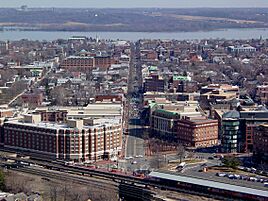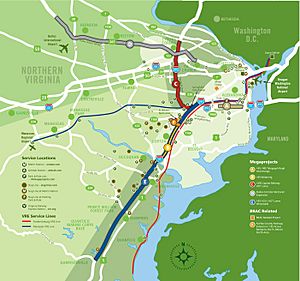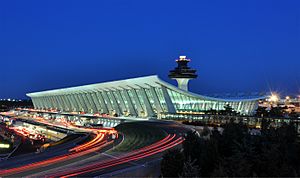Northern Virginia facts for kids
Quick facts for kids
Northern Virginia
|
|
|---|---|
|
Region
|
|
|
Clockwise from the top left: Tysons station entrance on the Metro Silver Line, The Pentagon, Reston and the Dulles Toll Road, Old Town Alexandria, Mount Vernon
|
|
| Nickname(s):
NOVA, NoVA, Nova
|
|
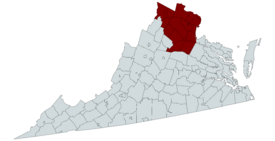
The counties of Virginia that form part of the Washington–Baltimore combined statistical area
|
|
| Country | |
| State | |
| Counties and independent cities | Alexandria, Arlington County, Clarke County, Culpeper County, Fairfax, Fairfax County, Falls Church, Fauquier County, Frederick County, Fredericksburg, Loudoun County, Manassas, Manassas Park, Orange County, Prince William County, Rappahannock County, Spotsylvania County, Stafford County, Warren County, Winchester |
| Largest city | Alexandria |
| Area | |
| • Land | 11,425.6 km2 (4,411.45 sq mi) |
| 13 counties and 7 independent cities in Virginia within the Washington Metropolitan Statistical Area or Washington-Baltimore Combined Statistical Area | |
| Population
(2023)
|
3,257,133 |
| • Density | 285.07/km2 (738.34/sq mi) |
| Demonym(s) | Northern Virginian |
Northern Virginia, often called NOVA or NoVA, is a busy and important region in the state of Virginia, United States. It includes several counties and independent cities. This area stretches out from Washington, D.C., which is the nation's capital.
As of 2023, about 3.2 million people live here. This means over one-third of Virginia's entire population lives in Northern Virginia. It is the most populated part of Virginia and the larger Washington metropolitan area.
Northern Virginia has more jobs than Washington, D.C., or the Maryland suburbs. It is also the richest part of Virginia. Many of its counties have some of the highest incomes in the whole country.
The region has a great transportation system. It includes two major airports: Ronald Reagan Washington National and Dulles International Airport. There are also subway lines, commuter trains, buses, bike paths, and many Interstate highways.
Important government buildings are in Northern Virginia. These include The Pentagon, which is the headquarters for the U.S. Department of Defense. It is one of the world's largest office buildings. The George Bush Center for Intelligence, home to the Central Intelligence Agency, is also here. Many big companies, especially those working with the government, are located in this region.
Northern Virginia is also a popular place for tourists. You can visit historical sites from the Colonial and Civil War eras. Some famous spots are Arlington National Cemetery, Mount Vernon, and the Udvar-Hazy Center of the National Air and Space Museum. You can also enjoy nature at places like Great Falls Park and parts of Shenandoah National Park.
Contents
- What's in a Name? The Story of "Northern Virginia"
- A Look Back: Northern Virginia's History
- Working Together: Regional Organizations
- Who Lives Here? Demographics
- Northern Virginia's Economy
- Fun Things to Do: Attractions
- Northern Virginia's Culture and Recreation
- Getting Around: Transportation
- Learning and Growing: Education
What's in a Name? The Story of "Northern Virginia"
The name "Northern Virginia" is usually spelled with a capital 'N'. This is because it refers to a specific place, not just a direction.
In the past, this area was sometimes called the "Northern Neck of Virginia." This name described a large piece of land between the Potomac River and the Rappahannock River. This land was given to early settlers by the King of England.
Over time, the eastern part of this land became known as "the Northern Neck." The areas further west started to be called "Northern Virginia." One of the first big uses of the name "Northern Virginia" was for the Confederate Army of Northern Virginia during the American Civil War (1861–1865).
Defining Northern Virginia Today
Today, "Northern Virginia" usually means the counties and cities in Virginia that are part of the larger Baltimore–Washington metropolitan area.
This includes five counties: Arlington, Fairfax, Loudoun, Prince William, and Stafford. It also includes six independent cities: Alexandria, Fairfax, Falls Church, Fredericksburg, Manassas, and Manassas Park.
A Look Back: Northern Virginia's History
Colonial Times and Early Land Grants
The Colony of Virginia was first settled in 1607 at Jamestown. The land that is now Northern Virginia was part of a huge land grant from King Charles II of England in 1649.
Later, in 1673, a new grant was given to Thomas Lord Culpeper. He became the Royal Governor of Virginia. Culpeper County is named after him.
In 1736, Lord Culpeper's grandson, Thomas Fairfax, 6th Lord Fairfax of Cameron, took over the land. He was known as "Lord Fairfax." The land was officially called the "Northern Neck." In 1742, Fairfax County was named in his honor.
Lord Fairfax lived at "Belvoir" and later at "Greenway Court." Around 1748, he met a young George Washington, who was only 16 years old. Lord Fairfax was impressed and hired Washington to survey his lands. Lord Fairfax died in 1781, during the American Revolutionary War.
From Statehood to the Civil War
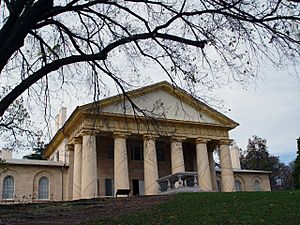
After the American Revolutionary War, the Thirteen Colonies formed the United States. George Washington became the first president. He supported making Washington, D.C. the new nation's capital. This city was built on land given by Maryland and Virginia.
The part of the capital given by Virginia was called Alexandria County. In 1846, this land was given back to Virginia. Today, this area includes Arlington County and part of the city of Alexandria.
The country faced big disagreements over slavery and states' rights. This led to the American Civil War (1861–1865). Virginia joined the Confederate States of America. Its capital was in Richmond.
Northern Virginia was right in the middle of the conflict. It was close to both the Union capital (Washington, D.C.) and the Confederate capital (Richmond). Many battles were fought here. The Army of Northern Virginia was the main Confederate army in the east.
After the war, Virginia split. The western, mountainous part of the state formed a new state called West Virginia in 1863. This meant some of the land originally part of Lord Fairfax's grant became part of West Virginia.
The 20th Century and the Rise of Technology
During the Cold War, the Department of Defense started using more technology. This helped Northern Virginia's economy grow a lot. The region became known as the "Silicon Valley" of the East Coast.
The internet also played a big role. One of the first major internet connection points, MAE-East, was set up in Ashburn in the 1990s. This is why many large data centers are still located in Northern Virginia today.
Northern Virginia in the 21st Century
In the early 2000s, the "dot-com bubble" burst, causing some economic challenges. However, after the September 11 attacks, defense spending increased. This helped the region's economy recover and grow. Many private companies that work with the federal government are based here.
Working Together: Regional Organizations
Northern Virginia Regional Commission
The Northern Virginia Regional Commission (NVRC) helps local governments work together. It includes 13 local governments from Northern Virginia. These include counties like Arlington and Fairfax. It also includes cities like Alexandria and Fairfax.
The NVRC shares information and provides services to its members. It helps with things like the environment, transportation, and community planning. It acts as a way for the different parts of the region to coordinate their efforts.
Metropolitan Washington Council of Governments
Northern Virginia is also a big part of the Metropolitan Washington Council of Governments (MWCOG). This group was started in 1957. It brings together 22 local governments from the Washington area.
MWCOG is a place for leaders to discuss important issues. They work on regional solutions for transportation, public safety, and economic growth.
Who Lives Here? Demographics
| Historical population | |||
|---|---|---|---|
| Census | Pop. | %± | |
| 1900 | 188,919 | — | |
| 1910 | 194,731 | 3.1% | |
| 1920 | 206,504 | 6.0% | |
| 1930 | 229,205 | 11.0% | |
| 1940 | 298,588 | 30.3% | |
| 1950 | 488,945 | 63.8% | |
| 1960 | 788,162 | 61.2% | |
| 1970 | 1,118,064 | 41.9% | |
| 1980 | 1,357,387 | 21.4% | |
| 1990 | 1,805,091 | 33.0% | |
| 2000 | 2,253,251 | 24.8% | |
| 2010 | 2,794,957 | 24.0% | |
| 2020 | 3,197,076 | 14.4% | |
| 2023 (est.) | 3,257,133 | 16.5% | |
| 1900–2020 | |||
As of April 2020, about 3.2 million people lived in Northern Virginia. This is about 37 percent of Virginia's total population.
Most of these people live in the "central" counties. These include Arlington, Fairfax, Loudoun, and Prince William. They also include cities like Alexandria and Fairfax.
Northern Virginia is home to people from many different backgrounds. There are large communities of people from Korea, Vietnam, India, and many other countries. There is also a big Hispanic population, including people from El Salvador, Peru, and Bolivia.
Education and Income in Northern Virginia
People in Northern Virginia are generally very well-educated. More than half of adults aged 25 or older have a bachelor's degree or higher. This is much higher than the national average. Many people also have advanced degrees.
The region is known for being wealthy. Many counties here have very high average household incomes. However, the cost of living in Northern Virginia is also very high. This means things like housing and food are more expensive than in other parts of the country.
Northern Virginia has many fancy shopping areas. For example, Tysons Galleria is known for its high-end stores. In 2002, National Geographic magazine called it "the Rodeo Drive of the East Coast."
Northern Virginia's Economy
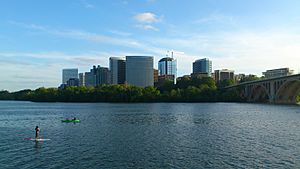
Northern Virginia is a major economic hub for the state. It has a huge amount of office space, much more than Washington, D.C., or its Maryland suburbs.
The unemployment rate in Northern Virginia is usually very low. It is often about half the national average. This means many people in the region have jobs.
The Internet Hub
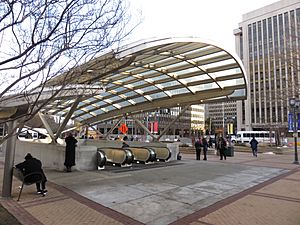
Northern Virginia is a very important place for the internet. A huge amount of internet traffic, up to 70 percent, flows through Loudoun County every day. It has the largest number of data centers in the world.
These data centers use a lot of electricity. Companies like Amazon have many servers located here. This makes Northern Virginia a global leader in internet infrastructure.
Major Companies in Northern Virginia
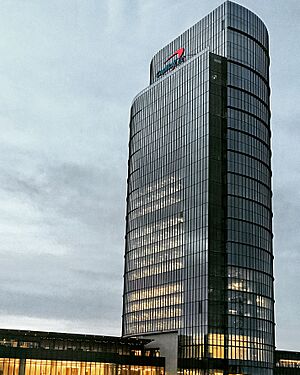
Many large and important companies have their headquarters in Northern Virginia. These include:
- Boeing (Aerospace and Defense)
- Booz Allen Hamilton (Information Technology Services)
- Capital One Financial (Banking)
- Freddie Mac (Financial Services)
- General Dynamics (Aerospace and Defense)
- Hilton Hotels Corporation (Hospitality)
- Northrop Grumman (Aerospace and Defense)
Some of the largest private companies are also here:
- Bechtel (Construction)
- Mars (Food and Drink)
Verisign, which manages internet domains like .com and .net, is also based in the region.
Fun Things to Do: Attractions

Northern Virginia has many exciting places to visit.
- Shopping: Large malls like Potomac Mills and Tysons Corner Center attract many shoppers.
- History: You can visit Civil War battlefields in Manassas and Fredericksburg. Old Town Alexandria is famous for its historic buildings, shops, and restaurants.
- Nature: Enjoy the outdoors at Great Falls Park or explore trails along the Potomac River. Mount Vernon, George Washington's home, is also a popular historical site.
- Museums: The Steven F. Udvar-Hazy Center is part of the National Air and Space Museum. It has huge aircraft and spacecraft on display.
- Performances: You can see concerts and shows at Wolf Trap National Park for the Performing Arts in Wolf Trap.
Northern Virginia's Culture and Recreation

Many people in Northern Virginia enjoy cultural events in Washington, D.C.. The Kennedy Center is a popular spot for shows. Closer to home, Wolf Trap National Park for the Performing Arts offers outdoor concerts.
Large venues like Jiffy Lube Live and EagleBank Arena host major concerts and sporting events. The Steven F. Udvar-Hazy Center is also a favorite cultural spot.
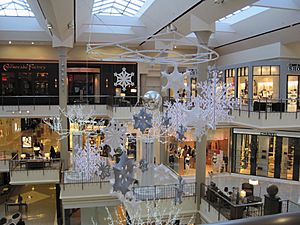
Shopping is a big part of the culture here. Tysons Corner Center is one of the biggest malls in the country. Tysons Galleria has more luxury stores. Other popular malls include Fair Oaks Mall and Potomac Mills, which is a large outlet mall.
Fun and Games: Recreation
Northern Virginia offers many activities for families and individuals.
- Outdoor Activities: There are many trails for biking and walking, like the Washington and Old Dominion Rail Trail. You can also enjoy kayaking and rock climbing along the Potomac River.
- Sports: The region has many sports leagues. The Northern Virginia Swim League has over 100 community pools. Soccer leagues are also very popular.
- Parks and Historic Sites: Many parks and historic homes offer places to explore. George Washington's boyhood home, Ferry Farm, is in Stafford County.
Getting Around: Transportation
Airports in Northern Virginia

Northern Virginia has two major airports.
- Ronald Reagan Washington National Airport is in Crystal City. It is the busiest airport in the Washington area.
- Dulles International Airport is in Dulles. It is the main airport for international flights. Many airlines use Dulles, including United Airlines.
Subway and Trains
Commuters use the Washington Metro subway system. It is the second-busiest subway in the nation. The Metro's Silver Line now reaches Dulles International Airport and Loudoun County.
The Virginia Railway Express (VRE) is a commuter train system. It connects Northern Virginia to Washington, D.C. Buses also provide public transportation throughout the region.
Highways and Traffic
The Washington metropolitan area often has very heavy traffic. Northern Virginia has some of the worst traffic bottlenecks in the country. To help with this, people are encouraged to use public transport, carpool, or use special HOV lanes.
Major highways include Interstates 495 (the Capital Beltway), 95, 395, and 66. The Dulles Toll Road is also a key route.
Special "Express Lanes" are available on some highways. Drivers with an E-ZPass can pay a fee to use these lanes, which helps them avoid traffic. These lanes are being expanded to help ease congestion.
Crossing the Potomac River can also be a challenge due to traffic. Many people who work in Northern Virginia live in more affordable areas further away. This creates a lot of traffic as they commute.
Learning and Growing: Education
Schools in Northern Virginia

Fairfax County has a large public school system. It includes Thomas Jefferson High School for Science and Technology. This is a highly-ranked magnet school known for its science and technology programs. Many schools in the region are ranked among the best in the country.
Colleges and Universities
Northern Virginia is home to several colleges and universities.
- George Mason University in Fairfax is the largest public university in Virginia.
- Northern Virginia Community College (NOVA) has several campuses throughout the region.
- University of Mary Washington is in Fredericksburg.
- Marymount University is in Arlington.
Other universities, like the University of Virginia and Virginia Tech, also have campuses or centers in Northern Virginia.






